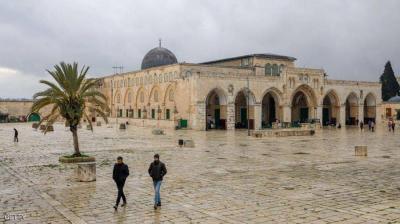Under the title "Al-Aqsa Mosque: A Witness to Thousands of Years of History," Sky News Arabia published an article about the design of Al-Aqsa Mosque and its significance for the three religions. The article indicated that the importance of Al-Aqsa Mosque stems from its religious value to Muslims as it is the first qibla (direction of prayer), the third holiest site, and the place from where the Prophet Muhammad (peace be upon him) was transported during the Night Journey. Additionally, it is the second mosque built in Islam after the Sacred Mosque.
The exact date of the mosque's initial construction is not precisely known, and historians disagree on who laid the first stone of Al-Aqsa Mosque. Some believe that the Prophet Adam, the father of mankind, built it, while others attribute its construction to Shem, the son of Noah, and some say that it was the Prophet Abraham who initiated its building. When Al-Aqsa Mosque was first constructed, it was basic and made of earthen clay, and it has been rebuilt and redesigned multiple times throughout the ages.
The first grand construction of Al-Aqsa Mosque occurred during the Umayyad period, covering a vast area, yet it suffered damage from an earthquake that led to the destruction of its western and eastern sides. It was then restored by the Abbasid caliph, but it experienced another earthquake, requiring further restoration by the Abbasid caliphate. The mosque did not remain intact for long as it was again damaged by an earthquake that destroyed most of its structure, leading to restoration and reconstruction during the Umayyad period.
### The Significance of Jerusalem for Followers of the Three Religions
The city of Jerusalem is not only of historical significance but has also held religious importance throughout history for Muslims, Christians, and Jews. Besides the significance of Al-Aqsa Mosque to Muslims, there is, specifically within the Christian Quarter, the Church of the Holy Sepulchre, which holds a special importance for Christians worldwide. Many believe that Jesus Christ was crucified there, and his tomb is within the church, which also coincidentally is where he is believed to have risen from the dead.
For Jews, the city's significance is embodied in the Western Wall, which they believe is what remains of Solomon's Temple, the holiest site for Jews. It is also believed to be the location where the Prophet Abraham was to sacrifice his son Ishmael.
### The Design and Area of the Mosque
Al-Aqsa Mosque covers an area of approximately 14,000 square meters. The lengths of the surrounding wall from all four sides are as follows: western 491 meters, eastern 462 meters, northern 310 meters, and southern 281 meters. Presently, the mosque has four minarets dating back to the Mamluk era. Al-Aqsa Mosque consists of several buildings and contains many different parts amounting to 200 significant features. It includes a large central arcade supported by marble columns, topped with a gabled roof in lead colors, and ends with a grand dome resting on four stone supports topped by four stone arches.
The dome itself consists of an inner and an outer layer, decorated with mosaic patterns on the inside, while the exterior is covered with copper plates coated in gold. On either side of the central arcade, there are three additional arcades that run parallel to the central one and are shorter in height.
Historically, Al-Aqsa Mosque has 15 doors, of which 10 are open and 5 are closed. Some Muslims confuse their perception of Al-Aqsa Mosque, with some considering it to be the building with the golden dome, referring to the Dome of the Rock, while others think the blessed Al-Aqsa is the structure with the black lead dome (the Qibli Mosque). However, the true concept of Al-Aqsa encompasses everything within the wall that surrounds the Al-Aqsa area and its facilities.




